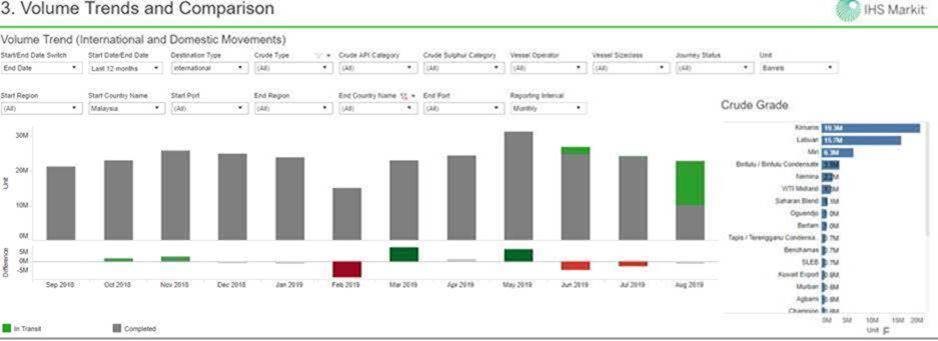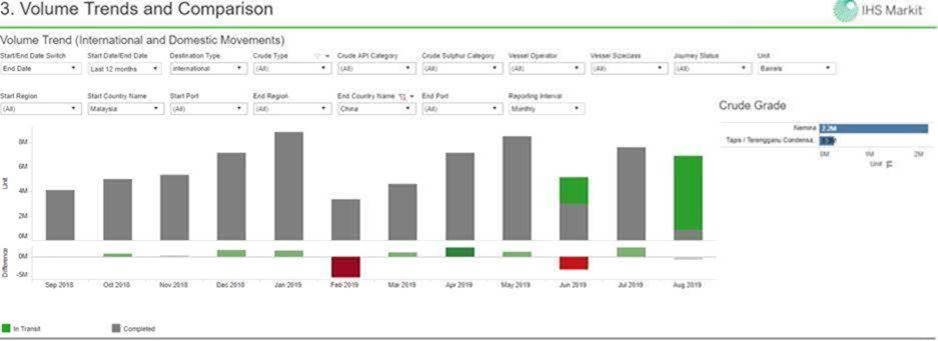Singma, the newest grade of blended crude oil to emerge from Malaysia, is being offered in the market for likely shipment to China as traders use supertankers anchored in waters off Malaysia and Singapore as well as onshore tanks to mix a variety of grades for export, according to market sources.
The crudes that end up in the pool include grades from West Africa, contaminated Urals, sanctioned oil from Venezuela and Iran plus mainstay grades from the Middle East, they said.
The moves through ship-to-ship (STS) transfers, involving multiple loadings and discharges on board ultra and very large crude carriers (ULCCs and VLCCs) help mask the origin of the crude to create a new blend that is then sold overseas, especially to thirsty independent refiners in China.
“I think the Singma crude could be Venezuelan origin,” said one source. “Some China domestic traders and teapots are rumored to be receivers.”
The U.S. has imposed sanctions against Venezuela and Iran, which make it near impossible for anyone on the oil supply chain, from shipowners to traders, to handle cargoes from these two countries without incurring penalties from Washington.
It is no longer a simple case of re-documenting the origin of crude oil cargoes as current technology makes it difficult to get away with such forged documents, thus leading to the creation of these exotic blends in recent months, market sources said.
One of the biggest grade to emerge in the past year is Nemina blend, which until then did not exist in global crude oil circles, yet one Aframax cargo each (about 700,000 bbls) was delivered to China in May and June, according to data from IHS Markit’s Commodities At Sea (CAS).
The cargoes originated from the Sungai Linggi Transshipment Area, a well-known and active STS zone in the Straits of Malacca, CAS data showed.

Market sources said that the number of STS operations have soared compared with as early as five years ago even though the crude oil market is firmly backwardated, meaning there’s no floating storage play. Tankers load and discharge at transshipment points in part to break bulk but also to muddle oil flows and raise uncertainties as to the exact origin and volume on board.
Some of these are done to circumvent sanctions while others are driven purely by commercial interest as traders seek to keep oil trades as murky as possible in the face of technological challenges.
According to Chinese customs data, the nation imported 325,000 b/d (9.75 million bbls) of crude oil from Malaysia in May, which was a record. The volume is more than half of Malaysia’s entire oil production. Purchases for June arrival reached 248,000 b/d, the data showed.
CAS data show that unlike exports to countries such as India, Thailand, Indonesia, Singapore and Australia where mainstay Malaysian crude grades such as Kimanis, Labuan, Miri and Bintulu dominate, recent shipments to China do not include any of these grades.
Nemina shows up as the largest grade sold to China in the past year and there no descriptions for the other volumes sold, according to CAS data.

Ship tracking services struggle to keep track of the cargoes delivered due to these multiple STS activities and consequently rely on customs declarations for the identity of the crude.
For example, according to port agent reports the Suezmax Patroclus is scheduled to discharge around 1.1 million barrels of crude labeled as Mal Blend at Qingdao port in China. It’s unclear if this Mal Blend is the same as Singma.
The Patroclus arrived at the trans-shipment area in the Straits of Malacca on July 20 with a draught of 9.2 meters and after circling the area for about 10 days it left on July 30 with a draught of 17.1 meters, meaning in this time it had picked up cargoes, according to data from IHS Markit’s Market Intelligence Network (MINT).
There are no records of STS operations in the Straits of Malacca, according to MINT data. The tanker is currently anchored outside Qingdao port, the data show.
Another report showed that the Suezmax Xin Hui Yang was the latest vessel to discharge a parcel of Nemina crude to China in end June. It unloaded about 950,000 barrels at Qingdao.
Crude oil exports from Singapore, a city-state that is not an oil producer, to China is also off the charts, according to CAS data but Chinese customs import data do not show any crude oil purchases from Singapore.

The confusion maybe due to shipments of fuel oil mistaken as crude and also where the STS operations take place, whether it’s in Singapore waters or very close to Singapore waters such as Tanjong Pelepas, which on satellite tracking services could lead to mislabeling.
But it does explain the large volumes shown coming from Malaysia. Crude oil exports from Malaysia to China were negligible before the second half of 2016 with zero shipments made in some months. However, in the past two years flows average in the hundreds of thousand barrels a day.
Last year a blend of condensate emerged as originating from Malaysia. Batu Pahat condensate, named after a coastal town in the southern Johore state sited along the Malacca Straits, was according to some sources Iranian South Pars but this could not be verified.
Market sources said that the introduction of Singma Blend is to be expected as sellers need to be able to differentiate the cargoes they are offering at least from a basic light/heavy and sweet/sour perspective.
-- Raj Rajendran, (Rajendran.Ramasamy@ihsmarkit.com)
Copyright, Oil Price Information Service
